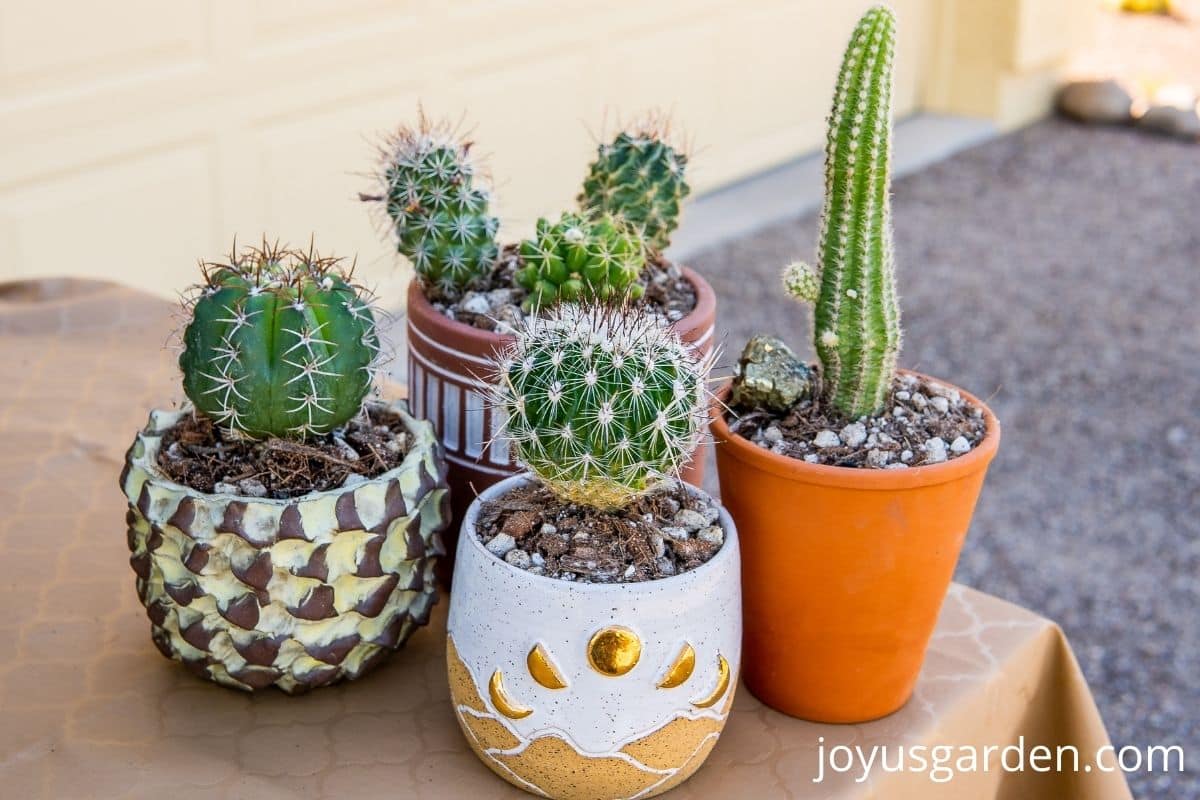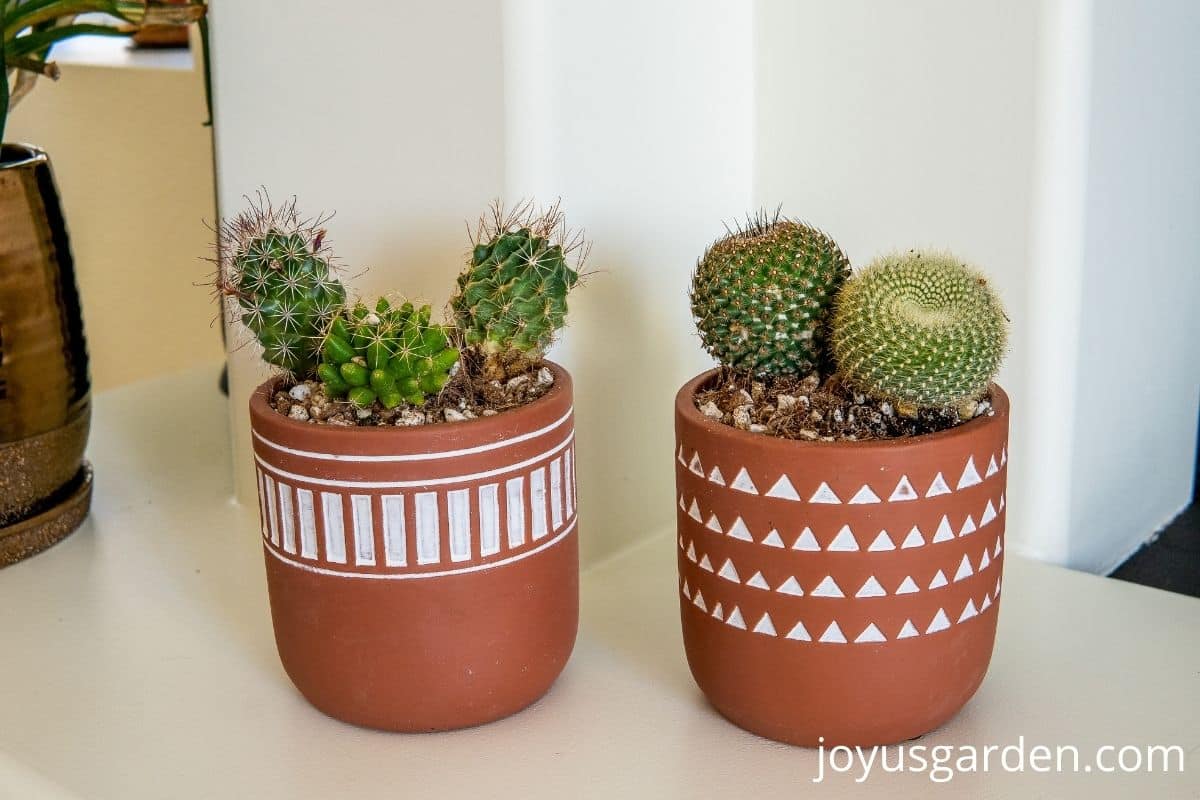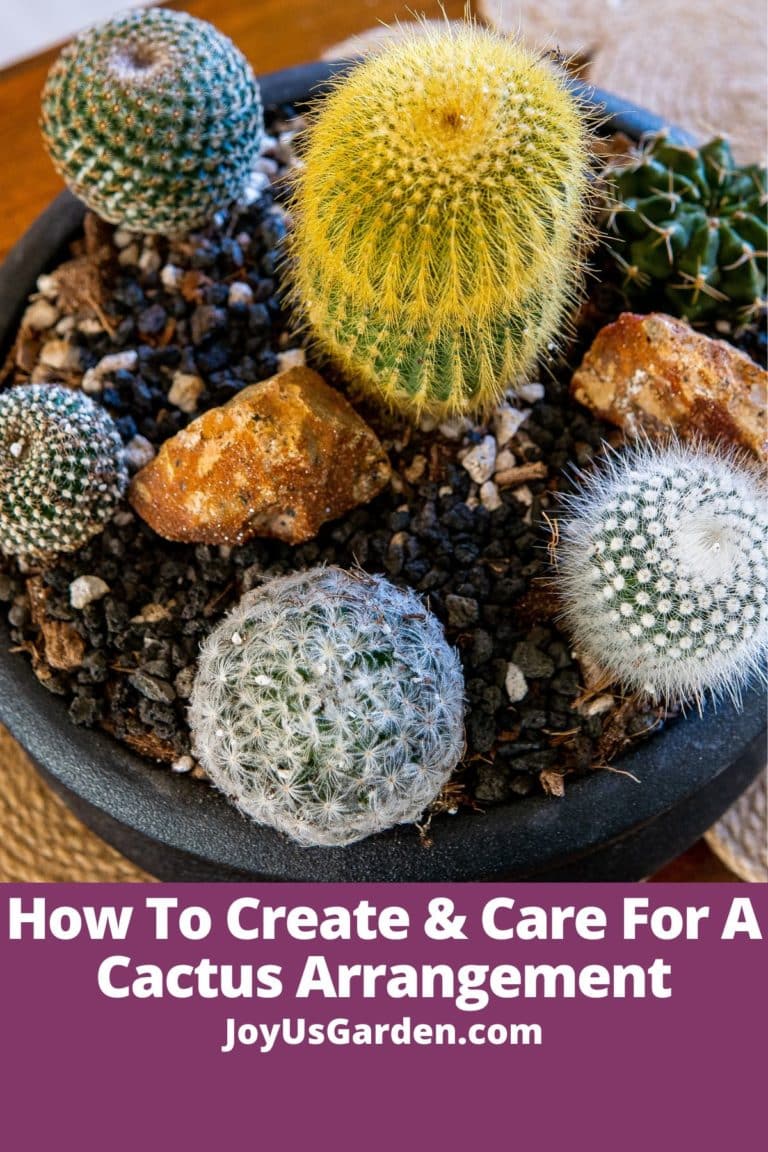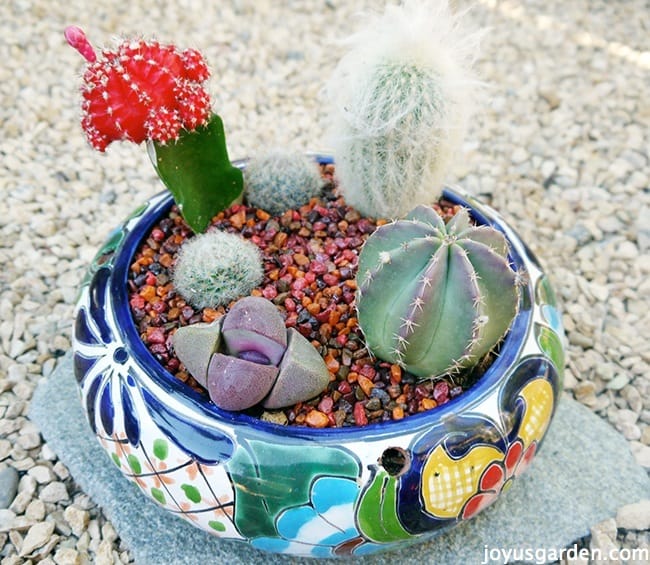Indoor Cactus Care: A Cactus Houseplant Guide
Cactus, you either love ’em or hate ’em. I live surrounded by cacti in the Sonoran Desert in Tucson, Arizona so I fall into the love category. Not only do I grow them in my garden, but in my home also. This is all about indoor cactus care and what you need to know to grow them successfully.
I’ll be talking about desert cacti here, not tropical cacti like Christmas Cactus. Most people think cactus, and they think spines! The majority of the cacti sold in the retail trade are in 2″, 4″, and 6″ grow pots. A 6′ cactus is expensive and hard to ship so this is caring for small cacti, those meant for tables, desks, shelves, and the like.
As far as choice goes, I’ve spoken with different growers and nurseries that sell cacti here in Tucson, and the consensus is if you have enough light, any small cacti you choose should do well. The small cactus plants that you’ll see below and in the series were bought from Eco Gro, Tucson Cactus and Koi, and Bach’s Cactus Nursery.
At the end of this post, you’ll find an indoor cactus care video as well as four sources to buy cacti online.
Cactus Characteristics

Growth Rate
Putting it plainly, cacti are slow growers. So, don’t be surprised if you don’t see much (if any) growth action in a year.
Size
They vary in height and width, depending on the type of cactus. Most are grown and sold for the houseplant trade in 2″, 3″, and 4″ grow pots.
Uses
These are tabletop plants. They’re also great to combine in low bowls to create gardens.
If you have kids, then you may want to place your cacti up out of reach. They’re fascinating plants, but not user-friendly!
Indoor Cactus Care
How Much Sunlight Do Cactus Need
Cactus and sun go hand in hand. They do best in high light exposure with lots of bright light and full sun.
These aren’t low-light plants. At least 6 hours of high light per day is their sweet spot. In general, cacti need more light than those fleshy succulent plants we all love.
Although they don’t do well in low light, just know that these little cacti can burn in the hot, direct sun, especially if in a window touching hot glass. If you’ve ever touched the hot glass, then you know what I mean! Even though they’re raised in greenhouses, the glass is white-washed to cut down the intensity of the sun.
Arizona is the sunniest state in the US. The majority of my indoor cacti are placed on open shelves in my very bright kitchen which has 4 good-sized windows and a sliding glass door.
If needed, rotate every couple of months so they evenly receive light on all sides.
In the darker winter months, you may have to move yours to a bright spot.
Related: How Much Sun Do Succulents Need, Indoor Succulent Care Basics
How Much Water Do Cactus Need
Here’s the question of the day–how often should you water a cactus indoors? You may think no water for months, but that isn’t true. They get by with little water, but not no water.
Here’s a rule of thumb when watering cacti indoors: let them completely dry out, and then water again. It’s best if the pot has at least one drainage hole, so all the excess water flows right out the bottom of the pot.
These cacti in small pots in high light conditions and warm temps need watering more often than every few months. In my sunny, warm climate, I water my small cacti every 3-to 4 weeks in summer.
A cactus growing in a 3″ pot or a garden growing in a low bowl is going to need watering more often than one growing in a 6″ pot.
These small cacti have shallow roots but the plants have mechanisms to store water. They’re subject to root rot if watered too frequently. How often you water yours depends on your climate, your home’s environment, the size of the pot, the soil composition, and the time of year.
In winter, I water my cacti less often and you most likely will need to do the same. It’s generally every 4-to-6 weeks from November through the end of February.
In terms of misting or spraying, don’t bother. You can save that for your tropical houseplants.
For all my houseplants, I use room temperature water from my tankless r/o system.
Related: How Often To Water Succulents, A Guide To Watering Succulents Indoors
Temperature
They like it warm but will tolerate cooler temps too. As I say in all care posts, if your house is comfortable for you, it’ll be so for your indoor plants as well.
Just make sure to keep your cacti away from cold drafts and any blasts from air conditioning or heating vents.
Humidity
This is where cacti differ from most other houseplants with origins in the subtropics or tropics. They like dry air which is good because most of our home environments are on the dry side. No need to mist or spray these babies!
In a high humidity environment, the soil will dry out a bit slower, so mind your watering frequency.
Fertilizer/Feeding
Every now and then, I get the question “what is the best fertilizer for cactus and succulents?”
I say, not too much or too often. 2-3 times a year during the active growing season for those growing in pots is sufficient.
I use balanced plant food, diluted to half strength. My current favorites for cacti are Maxsea All-Purpose (16-16-16) and Foxfarm Grow Big (6-4-4). These are the two foods I use for all my other houseplants too. There are specific cactus fertilizers on the market but I have no experience with them and don’t feel the need to use them.
Our growing season is long here in Tucson. I feed my cacti at the very beginning of spring, at the beginning of summer, and right before fall. In locations with a shorter growing season, once in spring and once in summer will be fine.
I also use a little worm compost/compost blend upon planting.
Soil/Repotting
I’m going to be doing separate posts and videos on these topics in a month or so this will be a brief overview.
The soil mix needs to be light, have lots of chunks for aeration, and to have the water drain right out. Regular potting soil is too heavy and can hold too much water which is something cactus don’t need or like.
I use this DIY Cactus and Succulent Mix Recipe for all my cacti and fleshy succulents.
If you don’t want to make your own, here are five popular mixes that you can buy online Bonsai Jack, Superfly Bonsai, Cactus Cult, Dr. Earth, and Tank’s.
Repotting a cactus can be painful but I have a trick I use which you’ll see in the repotting post and video.
I don’t repot my smaller cacti too often (maybe every 5 years or so) because they don’t need it. Unlike the larger cacti that grow outdoors here, their root systems are on the shallow side.
And, I don’t go up more than one pot size unless the roots call for bigger.
Like the rest of my houseplants, I repot in spring, summer, and early fall.
Having at least 1 drain hole in the bottom of the pot is the best. In the repotting post and video, I’ll also be covering how to plant and maintain cacti in pots without drainage holes.
More Cactus Goodness: A Guide To Cactus Soil Mix, Repotting Cactus: Planting Cactus In Pots, Cactus Arrangement DIY, DIY Recipe For Cactus & Succulent Mix

Pruning
I did separate posts on Pruning Succulents but no need for one here because cacti grow so slow.
This is one component that makes indoor cactus care is super easy. Good news – none is rarely needed with these small plants!
Propagation
I’ve Propagated Succulents well over a hundred times. With cactus, it’s only been a few times because of the growth rate. It takes them a long, long time to crowd each other out!
I took babies off one of my mammillarias for replanting and propagated a couple of pads off my Bunny Ears Opuntia and my Joesph’s Coat Opuntia.
Pests
I’ve never seen any pests on my indoor cacti and don’t think it’s a big concern. When it comes to the oh-so-common Prickly Pears growing outdoors here in Tucson, the cochineal scale infestations can be quite heavy.
For this reason, I think there’s a slight chance that cacti indoors might get Mealybugs because they’re both sucking insects with a similar habit. Scale would be another pest to keep your eye out for.
Pet Safety
They are considered to be non-toxic on the ASPCA website. If your cats or dogs are eating cacti, there may be something wrong with them!
If your pet is “plant curious” then consider keeping the cactus plant out of their reach. You don’t want to deal with spines in mouths or paws.
Do Cactus Flower
Yes, they do. Most cacti, that I know of, bloom in the spring and others later in summer. The key to getting yours to flower is high light.
Indoor Cactus Care Video Guide
Where To Buy Cactus Online
1. Mountain Crest Gardens: Astrophytum // 2. Amazon: Variety Pack // 3. Etsy: Mini Cactus // 4. Planet Desert: Echinocereus
3 Essential Points
Here are the 3 most essential points to know about growing cacti indoors: they need high light, infrequent watering, and a light, chunky, well-aerated soil mix.
Indoor cactus care is simple as can be. Tabletop cacti are great for small spaces and won’t outgrow their pots anytime soon. Give one or two a try and see what I mean!
Happy gardening,
Nell











